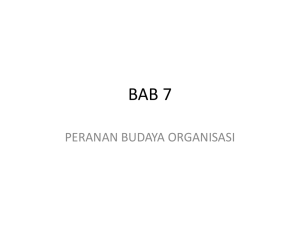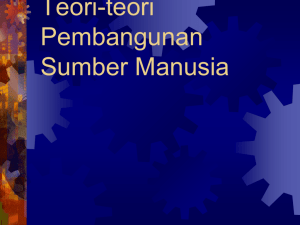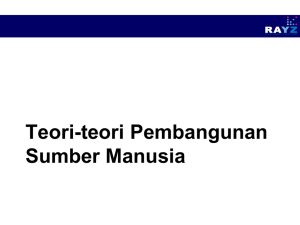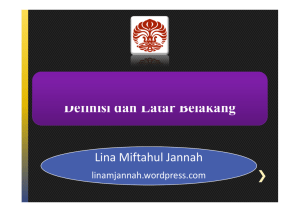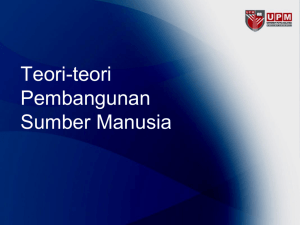Hygiene Factors
advertisement
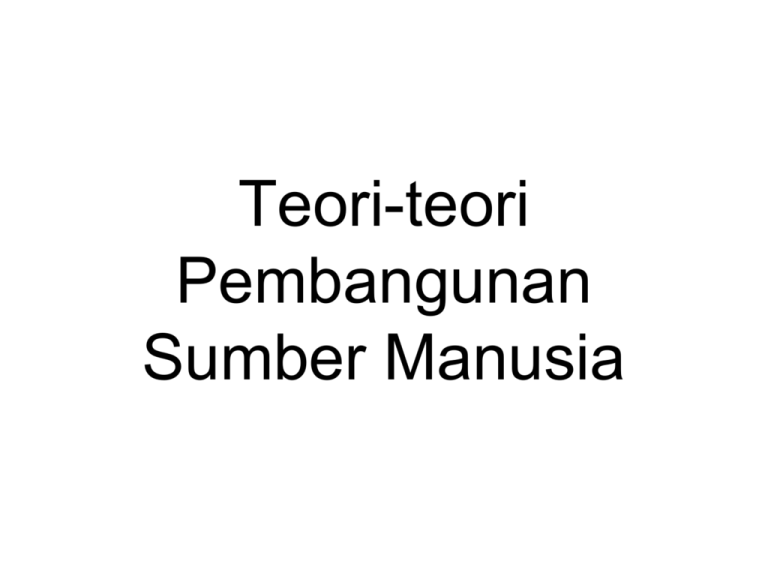
Teori-teori Pembangunan Sumber Manusia Grid Penguruan Blake dan Mouton Sistem Likert Teori Z Ouchi Teori Argyris Grid Pengurusan Blake dan Mouton Teori ini diperkenalkan pada 1964 bertujuan menerangkan huraian gaya kepimpinan pengurus untuk tujuan meningkatkan kecekapan dan keberkesanan organisasi. Pengurus yang efisyen: 1. Tumpu kepada pekerja (Teori Hubungan Kemanusiaan) 2. Tumpu kepada produktiviti (Teori Pengurusan Klasikal dan Saintifik) Grid Pengurusan Blake dan Mouton Grid kepimpinan utk menerangkan gaya kepimpinan. LIMA jenis gaya pengurusan: 1. Pengurusan Lemah (Impoverished Management) 2. Pengurusan Kelab Riadah (Country Club Management) 3. Authority-Compliance 4. Pengurusan Pasukan (Team Management) 5. Pengurusan Pertengahan (Mid-of-the-Road Management) The New Managerial Grid Insert Figure 2.2 Blake and Mouton’s Managerial Grid •Authority Compliance (9,1) •Classical theory •Country Club (1,9) •Informal grapevine •Impoverished (1,1) •Laissez-faire •Middle-of-the-Road (5,5) •Compromise (carrot & stick) •Team (9,9) •Human Resources Approach •Promote the conditions that integrate creativity, high productivity, and high morale through concerted team action Likert’s System of Management Exploitive Autocratic Benevolent Autocratic Consultative Participative Team Perbezaan keempat-empat sistem ada dari aspek motivasi, komunikasi, pembuatan keputusan, penyediaan maklumat, kawalan, struktur pengaruh dan persepsi. Kajian Likert mendapati kebanyakan organisasi mengamalkan sistem 4 ( Pembabitan Organisasi/ Participative Team) Ciri-ciri sistem 4: 1. Terdapat hubungan saling membantu ketua dan pekerja bawahan. 2. Proses pembuatan keputusan adalah secara kolektif. 3. Ahli organisasi juga merupakan ahli unit dalam organisasi. 4. Organisasi mempunyai matlamat pencapaian tinggi. Teori Z Ouchi Teori alternatif kepada Teori X dan Y dan teori ini adalah berdasarkan corak pengurusan Jepun. Teori Z lebih mengutamakan pembentukan dan penyuburan sumber manusia dalam organisasi. Teori Argyris Menekankan peranan individu dalam organisasi. Menyokong komunikasi terbuka dalam organisasi dan penglibatan dlm membuat keputusan. Implikasi Teori-teori Sumber Manusia terhadap Komunikasi Kandungan Komunikasi Arah Komunikasi Berkaitan tugas, sosial dan inovasi Pelbagai arah dan antara kumpulan Saluran Komunikasi Semua saluran Gaya komunikasi Formal dan tidak formal Kesimpulan Pendekatan Sumber Manusia dalam pengurusan adalah kesan kelemahan Teori Hubungan Kemanusiaan. Prinsip-prinsip Sumber Manusia dapat dibentuk dalam organisasi menerusi partisipasi, proses pembuatan keputusan, daya inovasi. Ini jelas menerusi teori Grid Pengurusan Blake dan Mouton, Sistem Likert 4, Teori Z Ouchi dan Teori Argyris. Terdapat sifat kepelbagaian dalam komunikasi dalam organisasi sumber manusia. Teori Sistem Ludwig Von Bertalanffy Merujuk kepada organisasi sebagai mempunyai TIGA komponen: Susunan Hierarki (Hierarchical Ordering) Pembentukan organisasi menyerupai satu sistem yang kompleks seperti sistem biologi tubuh manusia. Di dalam sistem tersebut terdapat subsistem yang membantu proses pengorganisasian. Saling Bergantung dan Memerlukan (Interdependence) Satu sistem yang besar memerlukan sub-sistem yang kecil untuk beroperasi. Keterbukaan (Permeability) Organisasidiandaikan sebagai organism hidup yang memerlukan elemen luar untuk beroperasi. Elemen keterbukaan menyebabkan organisasi menerima inovasi luar. Proses Sistem Sistem diterjemahkan menerusi proses input-throughput-output. “inputs” adalah bahan atau maklumat persekitaran luar yang masuk ke dalam organisasi menerusi elemen keterbukaan. Menerusi proses transformasi aktiviti “throughput” berlaku dan menghasilkan “output”. Sistem mentransformasikan output kepada environment luar e.g. Kilang Perabut perabut public Bahan mentah “input” “throughput” “output” Ciri-ciri Sistem Holistik -- Sistem diterangkan sebagai menyeluruh/ besar. Sesuatu sistem itu bersifat holistik kerana setiap anggota sistem bergantung antara satu dengan yang lain. Organisasi juga akan kukuh apabila terdapat amalan berkerja bersama. Equifinality -- Untuk mencapai sesuatu matlamat itu banyak cara yang boleh dilakukan. Pelbagai cara tersebut akan dilakukan untuk tujuan pencapaian metlamat organisasi. Entropi Negatif -- Kecenderungan sistem yang mengamalkan dasar tertutup untuk mengalami kemusnahan. Sistem yang mengamalkan dasar terbuka mampu menghalang kemusnahan. Kepelbagaian Keperluan -- Kepelbagaian kaedah untuk mengawal pelbagai cabaran yang mungkin muncul daripada persekitaran sistem. Teori Sistem Sibernetiks -- dikembangkan oleh Norbert Wiener 1948 – 1954. Fokus kepada penerangan bagaimana satu sistem berupaya mencapai keseimbangan atau homeostasis kerana kewujudan pelbagai komponen yang saling berkait. Sistem Sibernertiks mementingkan tindak balas dalam memastikan keupayaan untuk berfungsi. Teori Maklumat -- Teori yang menekankan kepentingan maklumat dalam organisasi. Pertukaran maklumat merupakan keperluan kepada organisasi. Teori Budaya Organisasi Fokus terhadap apakah itu organisasi? Apakah yang dipunyai oleh organisasi. Empat komponen budaya kukuh: 1. Nilai 2. Wira (Heroes) 3. Upacara dan Amalan (Rituals) 4. Jaringan Budaya Budaya Organisasi adalah kompleks Budaya organisasi diterjemahkan menerusi upacara, peraturan komunikasi, “cerita”, kepercayaan, simbol. Kemunculan Budaya Organisasi adalah hasil interaksi ahli dalam organisasi. Walau bagaimanapun tidak wujud satu Budaya Organisasi yang unggul. Budaya organisasi mempunyai kesan terhadap bentuk dan struktur organisasi. Menerusi kajian berbentuk deskriptif pengkaji akan dapat memahami budaya organisasi dan mengenali organisasi tersebut. Budaya penting terhadap mengarahkan kejayaan organisasi. Apakah dengan melihat bangunan tersebut anda dapat memahami budaya organisasi tersebut? Motivation and Hygiene Factors Frederick Herzberg (1923 – 2000) Herzberg’s Motivation-Hygiene Theory • Focuses on outcomes that lead to higher motivation and job satisfaction, and those outcomes that can prevent dissatisfaction. –Motivator needs relate to the nature of the work itself—autonomy, responsibility, interesting work. –Hygiene needs are related to the physical and psychological context of the work—comfortable work environment, pay, job security. • Unsatisfied hygiene needs create dissatisfaction; satisfaction of hygiene needs does not lead to Two-factor Theory (or Motivation-Hygiene Theory) • Herzberg: – Job context is source of dissatisfaction • Problems with hygiene factors (e.g., pay, working conditions) lead to dissatisfaction; lack of problems means lack of dissatisfaction – Job content is the source of job satisfaction • Motivator factors (e.g., achievement, responsibility) link with job performance; if high, satisfaction high and performance strong Two-factor Theory (or Motivation-Hygiene Theory) • • Validity unconfirmed – not replicated using different methods Still does not explain individual differences, professional or cultural differences Motivators and Hygiene Factors • Frederick Herzberg theorized that two entirely separate dimensions contribute to an employee’s behavior at work—hygiene factors and motivators. – Hygiene factors are elements such as working conditions, pay, policies, interpersonal relationships – Motivators fulfill high-level needs and include achievement, recognition, responsibility and opportunity for growth Motivators and Hygiene Factors • Motivators satisfy subordinates–-the things which encourage them to attend work, comply to group or team goals, and produce. • They often are linked to performance. Positive recognition by a superior and among peers during a formal meeting is an example of this. Motivators and Hygiene Factors • Hygiene factors keep subordinates from being dissatisfied. They apply to subordinates regardless of performance. – Timely and thorough completion of and counseling on fitness evaluations are an example of a hygiene factor. – The act is expected. When it does not happen subordinates become dissatisfied and may come to believe that superiors are not taking care of them. • Satisfiers (motivators) and dissatisfiers (hygiene factors) lie on completely different scales and must be considered independently. Herzberg’s Two-Factor Theory • KITA versus “true” motivation – Short-term movement versus long-term motivation • Job enrichment is an attempt to instill an internal generator in the employee • Studies of Herzberg’s theory have included employees working in a variety of industries and jobs – Accountants, engineers, nurses, military officers, and others Hygiene Factors • Work environment & target basic needs • Range from dissatisfaction to no dissatisfaction • The presence of hygiene cannot lead to satisfaction or high levels of motivation • Perception that hygiene is an entitlement Hygiene Factors (cont) • Salary – Can it ever be enough? • Benefits – Health care costs, premium sharing • Company policy & administration • Work conditions – Office space, equipment, etc. Motivator Factors • Motivators – Tap needs for psychological growth – Job content: The work itself – Lead to high levels of employee motivation and satisfaction Motivator Factors (cont) • Examples – Recognition – Responsibility – Achievement – Growth and learning Herzberg’s Two-Factor Theory Hygiene Factors Motivator Factors (lower order needs) (higher order needs) • Salary • Company policies • Working conditions • Benefits • Job security High Job Dissatisfaction Prentice Hall, 2001 • Career Advancement • Personal growth • Recognition • Responsibility • Achievement 0 Chapter 6 Job Satisfaction High 39 Herzberg’s Two-Factor Theory Hygiene Factor - work condition related to dissatisfaction caused by discomfort or pain – maintenance factor – contributes to employee’s feeling not dissatisfied – contributes to absence of complaints Motivation Factor - work condition related to the satisfaction of the need for psychological growth – job enrichment – leads to superior performance & effort Motivation–Hygiene Theory of Motivation • Company policy & administration • Supervision • Interpersonal relations • Working conditions • Salary • Status • Security Hygiene factors avoid job dissatisfaction Motivation factors increase job satisfaction • • • • • • Achievement Achievement recognition Work itself Responsibility Advancement Growth • Salary? SOURCE: Adapted from Frederick Herzberg, The Managerial Choice: To be Efficient or to Be Human. (Salt Lake City: Olympus, 1982). Reprinted by permission. Motivation-Hygiene Combinations High M Low M high motivation low motivation High H few complaints few complaints high motivation low motivation Low H many complaints many complaints (Motivation = M, Hygiene = H) Job Satisfaction Job satisfaction = how positively or negatively individuals feel about their jobs • Observable informally through observation and interpretation of behaviour and words • Measured formally in questionnaires – E.g., Minnesota Satisfaction Questionnaire – E.g., Job Descriptive Index Effects of Job Satisfaction • Link to absenteeism – Satisfied have lower absenteeism • Link to turnover – Dissatisfied more likely to quit • Link to performance complex – Satisfaction is NOT good predictor of individual performance – Successful performance does seem to lead to greater satisfaction – Proper allocation of rewards can increase both performance and satisfaction Summary • Hygiene factors (dissatisfiers) are working conditions, pay, policies, interpersonal relationships • Motivators (satisfiers) fulfill high-level needs and include recognition, responsibility and opportunity for growth Organizational Information Theory Managing large amounts of information is one of the leading challenges for organizations. As new means of communication increase, the amount of messages we send and receive, and the speed of those messages increase. "Karl Weick developed an approach to describe the process by which organizations collect, manage, and use the information that they recieve" (West and Turner, p. 243). Organizational Information Theory In developing his approach, Weick focuses on the process rather than the structure. Here, his focus was on the exchange of information that takes place within organizations and how individuals within the oganization take steps to understand the material. "The focus of Organizational Information Theory is on the communication of information that is vital in determining the success of an organization" (West and Turner, p. 244). Karl E. Weick is the Rensis Likert Collegiate Professor of Organizational Behavior and Psychology Professor of Organizational Behavior and Human Resource Management Professor of Psychology at the University of Michigan. His PhD is from Ohio State University in Social and Organizational Psychology. Dr. Weick's Book The Social Psychology of Organizing, first published in 1969 and revised in 1979, was declared one of the nine best business books ever written by Inc Magazine in December of 1996. The organizing formulation has more recently been expanded into a book titled Sensemaking in Organizations. Dr. Weick's research interests include collective sensemaking under pressure, medical errors, hand-offs in extreme events, high reliability performance, improvisation, and continuous change. Dr. Weicks graduate level teaching focuses on the social psychology of organizing, micro foundations of organization studies, the craft of scholarship, and his executive education teaching focuses on the management of uncertainty through sensemaking and improvisation. Example Application Do you remember the Y2K scare? Companies and people world-wide who depended on computers were in a state of panic when they learned that their computers might not be compatible in the new millenium. NowBank was one of these companies. An associate named Dominique Martin was to head up operations for a Y2K conversion. However, the company had branches in Denver, Dallas, and also Phoenix. By way of videoconferencing, all teams would meet to discuss each branch's responsibilities. Upon meeting, many different areas of management began to arise. Areas such as providing updates, maintaining communication between all branches, and keeping their own division running made the operation stressful. As concerns began to escalate, Dominique realized that effective communication would be key to the success of the project. To manage all of the concerns, problems, and communication issues the team implemented aspects of Organizational Information Theory. With communication as the highest priority, NowBank was successful in their conversion. The company continues to run smooth. Influences on O.I.T. In Weick's first book The Social Psychology of Organizing, he presents "his theoretical approach explaining how organizations make sense of and use information". Weick states, "Organizations and their environments change so rapidly that it is unrealistic to show what they are like now, because that's not the way they are going to be later". However, Weick realized that complete knowledge could not come from one source. There must be other influences on communication and also relationships among individuals. Two other theories were explored. General System Theory General System Theory in developing his approach to examine how organizations manage their information. In order to make neccessary adjustments to reach a common goal, an organization must depend on combined information. Bertalanffy notes, "While in the past, science tried to explain observable phenomena by reducing them to an interplay of elementary units investigatable independantly of each other, conceptions appear in contemporary science that are concerned with what is somewhat vaguely termed "wholeness," i.e., problems of organizations. General System Theory, therefore, is the general science of "wholeness" (Bertalanffy, pp. 36 - 37). Ludwig von Bertalanffy's General Assumptions One way to explain the way in which organizations make sense out of information that may be ambiguous or confusing is Organizational Information Theory. This theory focuses "on the process of organizing members of an organization to manage information rather than on the structure of the organization itself". There are assumptions beneath Weick's Organizational Information Theory: Human Organizations engage in information processing to reduce equivocality of information The information an organization receives differs in terms of equivocality Human organizations exist in an information environment General Concepts Organizational Information Theory does include a significant number of concepts that are crucial to fully understand this theory. They are: information environment, information equivocality, and cycles of communication. Here is a brief explanation of each one: Information Environment "Information environment is a core concept in understanding how organizations are formed as well as how they process information. Everyday, we are faced with thousands of stimuli that we could potentially process and interpret. The availability of all stimuli is considered to be the information environment. Information Equivocality "Organizations receive information from multiple sources; They must decode the information and determine whether it is comprehensible, which person or department is most qualified to deal with the information, and whether multiple departments require this information to accomplish their tasks. Without clarity in these areas, there is information equivocality" Cycles of Communication There are three steps to the cycle of communication. The three steps consist of act, response, and adjustment. The act "refers to the communication behaviors used to indicate one's ambiguity as a result of information that is received. The reaction to the act indicating equivocality of information defines the concept of response. A response of clarifying information is provided as a result of the act. As a result of the response, the organization formulates a response in return as a result of any adjustment that has been made to the information that was originally received. An adjustment is made to indicate that the information is now understood" Critique – Organizational Information Theory plays a very prevalent role in organizational communication. Communication is critical to our personal lives, our social lives, and also our professional lives. This theory has no limitations within organizational communication. It addresses aspects of the individual and also the group within the organization. Organizational Information Theory is a valuable theory to study and also practice. Theory X/Y • Douglas MacGregor, 1960 • Interaction between supervisors and subordinates • Organization’s management approach is determined by supervisors’ attitudes and belief about subordinates • Beginning of human relations movement Theory X • Role of Management – Management responsible for organizing elements of productive enterprise – People need to be controlled and directed – People would be passive otherwise • Human Nature – man works as little as possible – lacks ambition, dislikes responsibility, prefers to be led – inherently self-centered – naturally resistant to change – gullible, not very bright Theory Y • Role of Management – Management responsible for organizing elements of productive enterprise – Task of management is to arrange organizational conditions so that people can achieve their own goals best by directing their own efforts toward organizational objectives • Human Nature – People are not naturally passive, they have become so as a result of experience in organizations – Motivation and capacity for assuming responsibility is inherent in people Having Little Ambition Theory X Managers See Workers As… Disliking Work Avoiding Responsibility Self-Directed Theory Y Enjoying Work Managers See Workers As… Accepting Responsibility Prentice Hall, 2001 64 Theory X and Theory Y (Douglas McGregor) Theory X Assumes that employees dislike work, lack ambition, avoid responsibility, and must be directed and coerced to perform. Theory Y Assumes that employees like work, seek responsibility, are capable of making decisions, and exercise self-direction and self-control when committed to a goal. McGregor’s Theory X and Theory Y • Theory X – Management view that assumes workers generally dislike work and must be forced to do their jobs • Theory Y – Management view that assumes workers like to work and under proper conditions, employees will seek responsibility to satisfy social, esteem, and selfactualization needs Theory Z • A management philosophy that stresses employee participation in all aspects of company decision making Comparison of American, Japanese, and Theory Z Management Styles Variations on Theory Z • • • • Quality circles Participative management Employee involvement Self-directed work teams Did You Know? Theory Z lets employees feel organizational ownership, which may produce positive attitudinal and behavioral effects for employees. Maslow’s Theory “We each have a hierarchy of needs that ranges from "lower" to "higher." As lower needs are fulfilled there is a tendency for other, higher needs to emerge.” Daniels, 2004 Maslow’s Theory Maslow’s theory maintains that a person does not feel a higher need until the needs of the current level have been satisfied. Maslow's basic needs are as follows: Basic Human Needs • Food • Air • Water • Clothin g Physiological Needs • Sex Safety and Security Safety Needs Protection Stability Pain Avoidance Routine/Order Love and Belonging Social Needs Affection Acceptance Inclusion Esteem Esteem Needs Self-Respect Self-Esteem Respected by Others Self-Actualization Achieve full potential Fulfillment Summary Self-Actualization Esteem Belonging Safety Physiological
